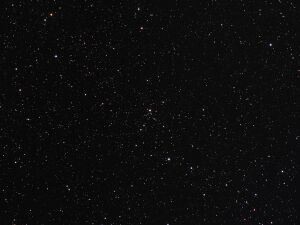Astronomy:NGC 433
From HandWiki
Short description: Open cluster in the constellation Cassiopeia
| NGC 433 | |
|---|---|
 | |
| Observation data (J2000 epoch) | |
| Constellation | Cassiopeia |
| Right ascension | 01h 15m 12.0s[1] |
| Declination | +60° 08′ 00″[1] |
| Distance | 6.5 kly (2.0 kpc)[1] |
| Physical characteristics | |
| Mass | 479+810 −301[2] M☉ |
| Estimated age | 65[2] Myr |
| Other designations | C 0112+598, OCISM 71, OCl 319, [KPR2004b] 16, [KPS2012] MWSC 0110.[3] |
NGC 433 is an open cluster in the northern constellation of Cassiopeia, located at a distance of 6,500 light years from the Sun.[1] It was discovered on September 29, 1829, by John Herschel, and was described by John Dreyer as "cluster, small, a little compressed."[4] The cluster is considered on the poor side, with only 12 stars above magnitude 16.[5] It has a linear diameter of 26.3 ly, with around 479 times the mass of the Sun and an age of 65 million years.[2]
References
- ↑ 1.0 1.1 1.2 1.3 Kharchenko, N. V. et al. (2005). "Astrophysical parameters of Galactic open clusters". Astronomy and Astrophysics 438 (3): 1163–1173. doi:10.1051/0004-6361:20042523. Bibcode: 2005A&A...438.1163K.
- ↑ 2.0 2.1 2.2 Joshi, Y. C. et al. (October 2016). "Study of open clusters within 1.8 kpc and understanding the Galactic structure". Astronomy & Astrophysics 593: 13. doi:10.1051/0004-6361/201628944. A116. Bibcode: 2016A&A...593A.116J.
- ↑ "NGC 433". SIMBAD. Centre de données astronomiques de Strasbourg. http://simbad.u-strasbg.fr/simbad/sim-basic?Ident=NGC+433.
- ↑ "New General Catalog Objects: NGC 400 - 449". Cseligman. http://cseligman.com/text/atlas/ngc4.htm#433.
- ↑ Battinelli, P. et al. (May 1992). "CCD Photometric and Spectroscopic Observations of the Young Open Cluster NGC 433". Astronomical Journal 103: 1596. doi:10.1086/116172. Bibcode: 1992AJ....103.1596B.
 |

